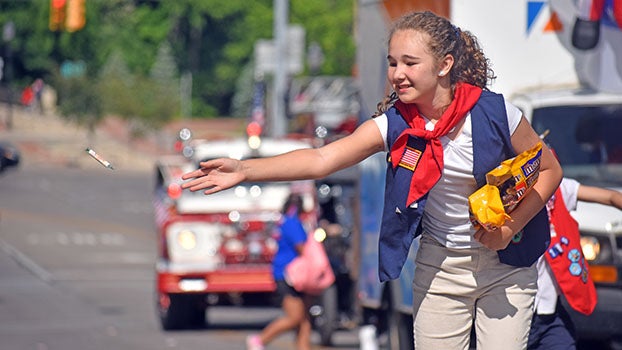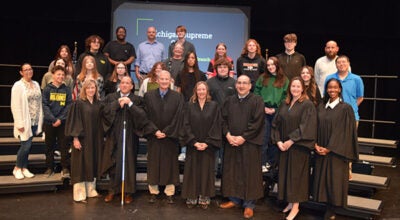Company’s Coming
Published 10:29 pm Thursday, July 28, 2011

Kim Gallagher, associate planner, Southwest Michigan Commission, Benton Harbor. (The Daily News/John Eby)
Is this community ready for company?
“I like to think about it like going to a party,” Kimberly Gallagher said. “You drive up the driveway and they have balloons on the mailbox to say, ‘Hello, you’re here, this is the right place.’ The lights are on, they might have a fire burning with something cooking, so you immediately feel welcome.
“Conversely, I’ve also been to someone’s house and wondered if tonight was really the night of the party? The walk’s not plowed. You don’t feel as welcome. I think a lot of our communities, some are really good at this hospitality and some are like the house that hasn’t been shoveled. Commerce always starts at places you don’t think about, like the gas station attendant, when someone asks for directions; when a person looks up on a Web site and calls a visitor’s bureau or Chamber of Commerce for information, how is that person’s request met?”
“With all the budget talks going on right now and everyone cutting, cutting, cutting,” Gallagher said, First Impressions visits to communities can be undertaken inexpensively by volunteers.
“The whole purpose of the program is to reveal the first impression a community makes to a visitor,” she said of the initiative adapted from an Extension agency in Wisconsin.
“You get an organization to champion it and identify a community you’d like to approach for an exchange,” Gallagher said, “and you get some volunteers together. You only need five or six people. Prior to the visit you have a secret shopper look through brochures and printed materials and you start writing down your impressions. Three to six people drive over to the town you’ve agreed to do community first impressions with. FIrst, you drive through without stopping and write that down. Then, enter and exit the community through all of the major entrances, comment on your observations for each entrance. During this assessment, they drive through neighborhoods, making comments. Throughout this template, you’re answering questions. I think one of the most interesting and powerful things is information from local residents and what they recommend.”
Best dessert, best dinner or dining experience, best burgers, where to get gourmet picnic items, where to find a breathtaking sunrise or sunset, where you can check e-mail, the best place to take a photo that proves you were here, where to get the perfect gift to remember the visit by, what places in town have been rated by a third party, the best place to take a hike and what season, the best places to stay, where to hike with a dog, where to find information on bike tours, where to find a movie theater and what would you tell someone from Detroit or Chicago who asks, “What can I do or buy in your town that I cannot get closer to home?”
“This is colorful information,” Gallagher said. “It’s like arming your local businesses with as much information as you can because it’s all about building a positive attitude about their community. People a lot of times don’t think about using their senses. What did you smell? What does a community taste like? For example, in St. Joe, the boat launch is by the sewage plant. It will take your breath away. I’m glad it’s fishermen who primarily use that and not a bunch of high-maintenance people.”
“Then the next thing is bringing you back,” she said. “It’s working at making an experience in your community. I’ll take the Dogwood Fine Arts Festival as an example,” she told an audience which also included Shirley Laylin and Bobbie Jo Hartline as guests of program chairman City Clerk James Snow.
“Some attend the Dogwood Festival for their first time and has a terrific time,” Gallagher said. “Maybe they had dinner at Wood Fire, and I know there are other places here. Now that becomes a destination. It’s adding on those memorable experiences for reasons to return to one event that’s a destination. In my planner mode I look at infrastructure,” including sidewalks, restrooms, way-finding signage, benches and drinking fountains.
She singled out some “contradictory signage,” like the no wheelchairs placard placed next to a handicapped parking zone. “If you look for these, you will be shocked at how many you see,” Gallagher said. “Like a welcome sign next to a no parking sign. It’s subliminal. If you have a public restroom, can someone with a wheelchair get in there? I was just looking at this glorious spray park in St. Joe down below the bluff, but there’s no shade. You’ll see people huddled in little areas of shade. If you’re thinking of benches, and skin cancer and heat that seems to keep going up, if you’re putting a public bench in, think about something for shade.”
Another sign didn’t stop at announcing there were no public restrooms, but directed visitors to the alley behind stores.
“That’s one of my pet peeves,” she admitted. “There’s a consignment store I love that only takes cash,” with a big sign that adds, “No checks. Cash. We mean it. That really encourages me to buy. Be clear, but not scolding.”
When the visit is documented, the towns exchange reports “and that’s kind of the start for your plan. There are high-end things a town can do to make it better, like public restrooms, but there are also inexpensive things towns can do. The best thank-you, if you will, is the return visitor. For some reason, your community, your business, made their visit special. It’s not always about the visitor bureau putting it out, but sometimes the initiative of a small business owner publicizing their own ideas of the best places to go. It is all about hospitality. And, like the policeman did today, I encourage all of you to let folks know when you see something wrong.”
Gallagher spoke in Cassopolis Wednesday night, got home late and was “rushing around” Thursday morning, “threw on a dress and ran out the door.”
Getting gas in St. Joseph, a police officer approached her with a smile.
“That’s a really pretty dress you have on,” he complimented her, “but I’ve got to tell you that your zipper is down. Crazy things always happen to me.”
“This presentation is like that officer – having the guts to open up your mouth,” the associate planner for Southwest Michigan Planning Commission in Benton Harbor told Dowagiac Rotary Club Thursday noon at Elks Lodge 889.
“It’s not that one agency can do it, a city can’t do it, a tourism bureau can’t do it and one business can’t do it. It takes everyone and a lot of times it’s about opening up your eyes,” said Gallagher, whose duties include transit planning, maritime planning and heritage tourism planning, including the U.S. 12 Heritage Trail stretching from Michigan’s west shore at New Buffalo to its east shore at Detroit.
“I’ve been working on (the Heritage Trail) for the last seven years. My first day at the commission was actually the official designation of the highway. I drove across to Walker Tavern near Michigan International Speedway, Gov. Granholm came, there was a lot of wonderful hoopla. I spent the prior five years with St. Joseph Today as downtown director. It’s a pretty easy sell because tourists like to come to St. Joe because it’s got a lot of amenities. I was excited to take on the heritage project with a 212-mile route. As I drove, I started to think how different this was from what I was used to. Everyone on that council had a great love for their community, their attraction, their business, but what we had to get to was the conversation about putting all that together and are you really ready for company? One of the best tools we’ve found for letting people know is the Web site,” www.us12heritagetrail.org.
Last year there were 42,130 page views, of which 75 percent of visitors were new.
“They spend about three minutes on the site,” she said. “I’ve also started posting on Facebook, which encourages more visitors, interaction and constant feedback.”
Gallagher likens the Web site to “sending out invitations for people to come visit. We’ve put a really concerted effort into giving them all the reasons why they should come and visit. That’s the first thing, is to look at your invitation,” keeping in mind the rule of thumb to offer four hours of activities for every hour of travel time.
“There are Niles re-enactment days,” she said. “There’s the U.S. 12 garage sale (Aug. 12-14), which I say is Michigan’s longest. I don’t know if it is, but nobody’s challenged it, so I encourage you to claim whatever you’re involved in.”
The U.S 12 Heritage Trail brochure details a dozen attractions along the route: The Little River Railroad in Coldwater; Allen, the Antique Capital of Michigan, with more than 500 dealers, surpassing the town’s population; Capri Drive-In, Coldwater, rated as worthy of a detour by both USA Today and the New York Times; Randy’s Barbecue Shack in Irish Hills; Drier’s Meat Market with sawdust on the floors in Three Oaks; the Tasty Nut Shop and Soda Bar in White Pigeon; Chicago Pike Inn and Spa in Coldwater; Grayfield Inn in a restored 1890s train depot in Jonesville; Sans-Souci Euro Inn (French for “no worry”) in New Buffalo; McCourtie Park’s 17 faux obis bridges (carving cement to look like logs, planks and ropes), Somerset Center; Rentschler Farm, a 12-room house restored with period furniture to depict rural life during the Great Depression, in Saline; and Hidden Lake Gardens, home to the Midwest’s largest Bonsai collection, in Tipton.
One of the oldest road corridors east of the Mississippi River, U.S. 12 Heritage Trail has been variously known as the Sauk Trail, Chicago Road and Michigan Avenue.
The corridor originally consisted of a network of centuries-old trails created by Native Americans.
During the 1820s, a military road was established that followed these trails. It became an important migration route for settlers of the Michigan territory.
Paved in the early 1920s, the road was officially designated a U.S. highway (U.S. 112) in 1926. Its designation changed to U.S. 12 50 years ago in 1961.






